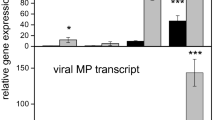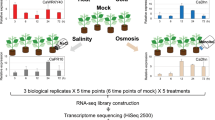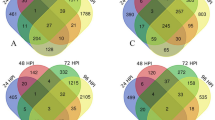Abstract
Hot pepper (Capsicum annuum) is one of the most consumed vegetable crops in the world and useful to human as it has many nutritional and medicinal values. Genomic resources of pepper are publically available since the pepper genomes have been completed and massive data such as transcriptomes have been deposited. Nevertheless, global transcriptome profiling is needed to identify molecular mechanisms related to agronomic traits in pepper, but limited analyses are published. Here, we report the comprehensive analysis of pepper transcriptomes during fruit ripening and pathogen infection. For the ripening, transcriptome data were obtained from placenta and pericarp at seven developmental stages. To reveal global transcriptomic landscapes during infection, leaves at six time points post-infection by one of three pathogens (Phytophthora infestans, Pepper mottle virus, and Tobacco mosaic virus P0 strain) were profiled. The massive parallel transcriptome profiling in this study will serve as a valuable resource for detection of molecular networks of fruit development and disease resistance in Capsicum annuum.
Design Type(s) | disease state design • transcription profiling by high throughput sequencing design • organism development design |
Measurement Type(s) | transcription profiling assay |
Technology Type(s) | RNA sequencing |
Factor Type(s) | fruit ripening stage • Pathogen • Timepoint • biological replicate |
Sample Characteristic(s) | Capsicum annuum • placenta • pericarp • leaf |
Machine-accessible metadata file describing the reported data (ISA-Tab format)
Similar content being viewed by others
Background and Summary
Large amounts of transcriptome data have been released using next-generation sequencing technology for past decades, which enables us to study organisms in a genomic perspective. In plants, global gene expression profiling was performed to elucidate molecular mechanisms for organ specificity, developmental changes, and disease resistance1–10. For example, the transcriptome analysis on developing seeds suggested that transcriptional change in endosperm and embryo was regulated by distinct co-expressed networks in wheat and maize1,2. In addition, the expression analysis of pathogen infected leaves in Arabidopsis and tomato revealed that a number of genes and networks interacted with each other in a specific time and a stage7–10. A recent study using multiple transcriptomes identified the vacuolar protease SLVPE3 and their target, serine protease inhibitor KTI4, involved in fruit ripening and disease resistance11. These genomic and transcriptomic studies have allowed us to unveil gene expression mechanisms and find target genes associated with agronomic traits.
Hot peppers (Capsicum spp.), belonging to Solanaceae family, are the most widely cultivated spice in the world. In 2013, the worldwide production of pepper was 31.1 million tons (14.6 billion US dollars), which was the third largest among vegetable crops12. The pepper fruits are rich sources of vitamin C, pigments, minerals and pungent agents that are known as nutritional and functional properties for human health13. The genus Capsicum consists of 33 undomesticated and five domesticated species including the most widely cultivated species, Capsicum annuum14. Various genetic studies for the pepper have been performed to unveil molecular mechanisms of important agronomic traits and disease resistance15–24. Recently, completion of the multiple reference pepper genomes with the deposited large amount of transcriptome data has enabled to perform in-depth analyses for these agronomical traits13,25–28. However, comprehensive transcriptome analyses to identify expression and expressional variations of genes using the large transcriptome resources of the peppers are still lacking.
In this study, we openly released the hot pepper transcriptomes that were previously published13,21,23. We described in detail the expression profiling methods of samples from fruit development, pathogen infection in each time point and tissues in C. annuum (Fig. 1). Total 125.68 Gb of transcriptome data from previously reported fruit tissues (pericarp and placenta) and infected leaves with P. infestans, Pepper mottle virus (PepMov), and Tobacco mosaic virus (TMV) P0 strain was generated (Table 1 and Data Citation 1). After preprocessing analyses, we mapped the remaining sequences to the reference pepper genome (Data Citation 1). The preprocessed sequences were validated through quality assessment (Fig. 2). A principal component analysis (PCA) showed the global gene expression patterns and variations between samples (Fig. 3). Consequently, the expression profiling of multiple conditions in pepper will provide valuable resources for analysis on fruit development, ripening and disease resistance.
The pepper transcriptome of fruit organs and pathogen- infected leaves including three biological replicates except for Mock-Up (n=2) were collected from NCBI SRA (SRP106410 and SRP119199). All raw sequences were pre-processed and assessed using FastQC (http://www.bioinformatics.babraham.ac.uk/projects/fastqc) and MultiQC. The filtered reads were mapped to Capsicum annuum reference genome (v.1.55) using CLC assembly. The mapped reads were normalized RPKM and log2 transformed mean value were used to PCA.
The log2 transformed mean RPKM values were plotted by boxplot function in R (a). The line plot (b) and scatter plots of PC1 versus PC2 (c) and PC1 versus PC3 (d) were drawn using previously published code with modification32. The abbreviations see method section 2.
Methods
Experimental overview
Massive transcriptome data for seven developmental stages in fruit (fruit development set) and six to seven time points in leaves infected by pathogens (pathogen infection set) were generated to decipher global gene expression profiling for fruit development and disease resistance in C. annuum. The reference pepper genome annotation v1.55 was used (http://peppergenome.snu.ac.kr). Reference mapping and normalization for filtered transcriptome were performed after quality filtering and assessment. A principal component analysis (PCA) was performed to elucidate global gene expression patterns and evaluate the correlation between samples using log2 transformed RPKM values (Fig. 1).
Transcriptome data generation
The transcriptome data in this study were acquired from CM334 dataset (Data Citation 2 and Data Citation 3). For transcriptome profiling of fruit development, pepper fruits at seven ripening stages were harvested at 6, 16, 25, 36, 38, 43, and 48 days post-anthesis (DPA) as previously described13. For transcriptome profiling of immune response to multiple pathogens, pepper leaves were inoculated with 15 μl droplets of 5×104 zoospores ml−1 suspension in P. infestans, and PepMov and TMV P0 strain purified from systemically infected tobacco leaves as previously described21,23. Inoculated leaves harvested at several time points from three biological replicates were ground in liquid nitrogen, which was used for total RNA purification. The strand-specific libraries with 150–200 bp insert size were constructed and sequenced with Illumina HiSeq 2000 and 2500 platforms (Illumina Inc., San Diego, USA) using fruit development set and pathogen infection set, respectively. Sample names were assigned: placenta (PL); pericarp (PR); stage 1, 6 DPA (1); stage 2, 16 DPA (2); stage 3, 25 DPA (3); mature green, 36 DPA (MG); breaker, 38 DPA (B); breaker plus 5, 43 DPA (B5); and breaker plus 10, 48 DPA (B10); control for P. infestans (TDW) and virus (Mock); infection for P. infestans (Pi), pepper mottle virus (PepMov), TMV P0 strain (TMV). Only single (forward) reads were used in pathogen infection set to reduce the read type variable for the fruit development set.
Pre-processing and quantification
The raw sequences of transcriptome were filtered and trimmed using previously described methods to remove contaminated and low quality reads13. The raw reads containing reference bacterial sequences were filtered using Bowtie2 v2.0.0-beta7 with modified parameters (--local –D 15 –R 2 –N 0 –L 20 –I S,1,0.65)29. The sequences with quality scores below 20 were trimmed using the CLC quality trimming software (CLC bio, Aarhus, Denmark). Minimum length cut-off for 50 bp and 101 bp read was 35 bp and 71 bp, respectively. The reads were validated using FastQC v0.11.5 (ref. 30) and MultiQC v1.3.dev0 (ref. 31) software with default parameters. The processed reads were mapped to the v.1.55 pepper CDS using CLC assembly cell with –s 0.99 –l 0.9 parameters (CLC bio, Aarhus, Denmark). Total mapped reads were normalized to reads per kilobase per million mapped reads (RPKM).
Principal component analysis (PCA)
Average RPKM values for each time point and tissue were used for PCA. To reduce the influence of extremely expressed genes, RPKM values were log2-transformed and boxplot was drawn using boxplot function in R. PCA was performed using previously published code with modification32.
Data Records
The detailed transcriptome information and average RPKM values for all pepper samples were deposited in figshare (Data Citation 1). The raw reads for transcriptome were deposited in NCBI Sequence Read Archive (SRA) accession (Data Citation 2 and Data Citation 3).
Technical Validation
Quality validation
To assess total data quality, we performed the quality check using FastQC and MultiQC software for all preprocessed samples. Overall, the mean quality scores in each base position were higher than 27 (Fig. 2a). The read counts per quality scores were distributed above 25 and average quality was higher than 35 (Fig. 2b). The normal distribution of GC content was indicating non-contaminated in sequencing process (Fig. 2c). The average sequence lengths were 50 bp and 99 bp for fruit development set and pathogen infection set, respectively (Fig. 2d). These numerical values represent that high-quality sequences were obtained for further analysis.
Global gene expression analysis
To elucidate global gene expression patterns in multiple conditions, filtered reads were mapped to pepper CDS and normalized by RPKM. The average RPKM values of three biological replicates in each sample were used for further analysis. A principal component analysis using log2 transformed RPKM showed that first three PCs explained most of the variance (Fig. 3a,b). The comparisons between PC1 and PC2 or PC3 indicated that the group of fruit organs and leaves infected by pathogen were separated clearly. In addition, the leaves infected by P. infestans and group of virus (PepMov and TMV P0 strain) showed a different pattern with minor overlap. (Fig. 3c,d).
Additional information
How to cite this article: Kim M.-S. et al. Global gene expression profiling for fruit organs and pathogen infections in the pepper, Capsicum annuum L. 5:180103 doi: 10.1038/sdata.2018.103 (2018).
Publisher’s note: Springer Nature remains neutral with regard to jurisdictional claims in published maps and institutional affiliations.
References
References
Lu, X. D. et al. The differential transcription network between embryo and endosperm in the early developing maize seed. Plant Physiol. 162, 440–455 (2013).
Pfeifer, M. et al. Genome interplay in the grain transcriptome of hexaploid bread wheat. Science 345, 1250091 (2014).
Digel, B., Pankin, A. & von Korff, M. Global transcriptome profiling of developing leaf and shoot apices reveals distinct genetic and environmental control of floral transition and inflorescence development in barley. Plant Cell 27, 2318–2334 (2015).
Han, Y. et al. Comparative RNA-seq analysis of transcriptome dynamics during petal development in Rosa chinensis. Sci. Rep 7, 43382 (2017).
Kang, C. Y. et al. Genome-scale transcriptomic insights into early-stage fruit development in woodland strawberry Fragaria vesca. Plant Cell 25, 1960–1978 (2013).
Li, J. Y. et al. Comprehensive RNA-Seq analysis on the regulation of tomato ripening by exogenous auxin. PLoS ONE 11, e0156453 (2016).
Jupe, J. et al. Phytophthora capsici-tomato interaction features dramatic shifts in gene expression associated with a hemi-biotrophic lifestyle. Genome Biol. 14, R63 (2013).
Lewis, L. A. et al. Transcriptional dynamics driving MAMP-triggered immunity and pathogen effector-mediated immunosuppression in Arabidopsis leaves following infection with Pseudomonas syringae pv. tomato DC3000. Plant Cell 27, 3038–3064 (2015).
Pombo, M. A. et al. Transcriptomic analysis reveals tomato genes whose expression is induced specifically during effector-triggered immunity and identifies the Epk1 protein kinase which is required for the host response to three bacterial effector proteins. Genome Biol. 15, 492 (2014).
Windram, O. et al. Arabidopsis defense against Botrytis cinerea: chronology and regulation deciphered by high-resolution temporal transcriptomic analysis. Plant Cell 24, 3530–3557 (2012).
Wang, W., Cai, J., Wang, P., Tian, S. & Qin, G. Post-transcriptional regulation of fruit ripening and disease resistance in tomato by the vacuolar protease SlVPE3. Genome Biol. 18, 47 (2017).
Food and Agriculture Organization of the United Nations. FAO statistics http://faostat.fao.org/ (2013).
Kim, S. et al. Genome sequence of the hot pepper provides insights into the evolution of pungency in Capsicum species. Nat. Genet. 46, 270–278 (2014).
van Zonneveld, M. et al. Screening genetic resources of Capsicum peppers in their primary center of diversity in Bolivia and Peru. PLoS ONE 10, e0134663 (2015).
Ramchiary, N., Kehie, M., Brahma, V., Kumaria, S. & Tandon, P. Application of genetics and genomics towards Capsicum translational research. Plant Biotechnol. Rep. 8, 101–123 (2014).
Caranta, C. et al. A complementation of two genes originating from susceptible Capsicum annuum lines confers a new and complete resistance to pepper veinal mottle virus. Phytopathology 86, 739–743 (1996).
Caranta, C., Thabuis, A. & Palloix, A. Development of a CAPS marker for the Pvr4 locus: a tool for pyramiding potyvirus resistance genes in pepper. Genome 42, 1111–1116 (1999).
Grube, R. C., Blauth, J. R., Arnedo, M. S., Caranta, C. & Jahn, M. K. Identification and comparative mapping of a dominant potyvirus resistance gene cluster in Capsicum. Theor. Appl. Genet. 101, 852–859 (2000).
Huh, S. U. et al. Capsicum annuum transcription factor WRKYa positively regulates defense response upon TMV infection and is a substrate of CaMK1 and CaMK2. Sci. Rep 5, 7981 (2015).
Tran, P. T., Choi, H., Choi, D. & Kim, K. H. Virus-induced gene silencing reveals signal transduction components required for the Pvr9-mediated hypersensitive response in Nicotiana benthamiana. Virology 495, 167–172 (2016).
Kang, W. H., Kim, S., Lee, H. A., Choi, D. & Yeom, S. I. Genome-wide analysis of Dof transcription factors reveals functional characteristics during development and response to biotic stresses in pepper. Sci. Rep 6, 33332 (2016).
Lee, H. A. et al. Multiple recognition of RXLR effectors is associated with nonhost resistance of pepper against Phytophthora infestans. New Phytol. 203, 926–938 (2014).
Lee, H. A., Kim, S., Kim, S. & Choi, D. Expansion of sesquiterpene biosynthetic gene clusters in pepper confers nonhost resistance to the Irish potato famine pathogen. New Phytol. 215, 1132–1143 (2017).
Kim, S. B. et al. Divergent evolution of multiple virus-resistance genes from a progenitor in Capsicum spp. New Phytol. 213, 886–899 (2017).
Kim, H. J. et al. Pepper EST database: comprehensive in silico tool for analyzing the chili pepper (Capsicum annuum) transcriptome. BMC Plant Biol. 8, 101 (2008).
Liu, F. et al. PepperHub, an informatics hub for the chili pepper research community. Mol. Plant 10, 1129–1132 (2017).
Qin, C. et al. Whole-genome sequencing of cultivated and wild peppers provides insights into Capsicum domestication and specialization. Proc. Natl. Acad. Sci. U.S.A. 111, 5135–5140 (2014).
Kim, S. et al. New reference genome sequences of hot pepper reveal the massive evolution of plant disease-resistance genes by retroduplication. Genome Biol. 18, 210 (2017).
Langmead, B. & Salzberg, S. L. Fast gapped-read alignment with Bowtie 2. Nat. Methods 9, 357–359 (2012).
Andrews, S. FastQC: a quality control tool for high throughput sequence data. Available online at http://www.bioinformatics.babraham.ac.uk/projects/fastqc (2010).
Ewels, P., Magnusson, M., Lundin, S. & Kaller, M. MultiQC: summarize analysis results for multiple tools and samples in a single report. Bioinformatics 32, 3047–3048 (2016).
Söllner, J. F. et al. An RNA-Seq atlas of gene expression in mouse and rat normal tissues. Scientific Data 4, 170185 (2017).
Data Citations
Kim, M.-S. et al. figshare https://doi.org/10.6084/m9.figshare.c.4070300 (2018)
NCBI Sequence Read Archive SRP119199 (2017)
NCBI Sequence Read Archive SRP106410 (2017)
Acknowledgements
This work was supported by a grant from the Agricultural Genome Center of the Next Generation Biogreen 21 Program of RDA (Project No. PJ01127501).
Author information
Authors and Affiliations
Contributions
D.C. conceived the project, designed the content, and organized the manuscript. M.-S.K. performed data collection, analysis, and wrote the manuscript. E.S., S.-I.Y., S.-B.K., and H.-A.L. generated the transcriptome data. S.K., J.J., K.-T.K., H.-A.L., H.-Y.L., J.P., Y.-H.L. and D.C. wrote the manuscript.
Corresponding author
Ethics declarations
Competing interests
The authors declare no competing interests.
ISA-Tab metadata
Rights and permissions
Open Access This article is licensed under a Creative Commons Attribution 4.0 International License, which permits use, sharing, adaptation, distribution and reproduction in any medium or format, as long as you give appropriate credit to the original author(s) and the source, provide a link to the Creative Commons license, and indicate if changes were made. The images or other third party material in this article are included in the article’s Creative Commons license, unless indicated otherwise in a credit line to the material. If material is not included in the article’s Creative Commons license and your intended use is not permitted by statutory regulation or exceeds the permitted use, you will need to obtain permission directly from the copyright holder. To view a copy of this license, visit http://creativecommons.org/licenses/by/4.0/ The Creative Commons Public Domain Dedication waiver http://creativecommons.org/publicdomain/zero/1.0/ applies to the metadata files made available in this article.
About this article
Cite this article
Kim, MS., Kim, S., Jeon, J. et al. Global gene expression profiling for fruit organs and pathogen infections in the pepper, Capsicum annuum L.. Sci Data 5, 180103 (2018). https://doi.org/10.1038/sdata.2018.103
Received:
Accepted:
Published:
DOI: https://doi.org/10.1038/sdata.2018.103
This article is cited by
-
The landscape of abiotic and biotic stress-responsive splice variants with deep RNA-seq datasets in hot pepper
Scientific Data (2024)
-
Global co-expression network for key factor selection on environmental stress RNA-seq dataset in Capsicum annuum
Scientific Data (2023)
-
The dissection of R genes and locus Pc5.1 in Phytophthora capsici infection provides a novel view of disease resistance in peppers
BMC Genomics (2021)
-
Comparative analysis of de novo genomes reveals dynamic intra-species divergence of NLRs in pepper
BMC Plant Biology (2021)
-
Transcriptome profiling of pepper leaves by RNA-Seq during an incompatible and a compatible pepper-tobamovirus interaction
Scientific Reports (2021)






